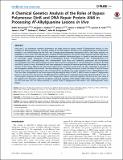| dc.contributor.author | Shrivastav, Nidhi | |
| dc.contributor.author | Li, Deyu | |
| dc.contributor.author | Delaney, James C. | |
| dc.contributor.author | Frick, Lauren E. | |
| dc.contributor.author | Foti, James J. | |
| dc.contributor.author | Walker, Graham C. | |
| dc.contributor.author | Essigmann, John M. | |
| dc.contributor.author | Fedeles, Bogdan I | |
| dc.date.accessioned | 2014-07-08T16:35:46Z | |
| dc.date.available | 2014-07-08T16:35:46Z | |
| dc.date.issued | 2014-04 | |
| dc.date.submitted | 2014-02 | |
| dc.identifier.issn | 1932-6203 | |
| dc.identifier.uri | http://hdl.handle.net/1721.1/88192 | |
| dc.description.abstract | DinB, the E. coli translesion synthesis polymerase, has been shown to bypass several N[superscript 2]-alkylguanine adducts in vitro, including N[superscript 2]-furfurylguanine, the structural analog of the DNA adduct formed by the antibacterial agent nitrofurazone. Recently, it was demonstrated that the Fe(II)- and α-ketoglutarate-dependent dioxygenase AlkB, a DNA repair enzyme, can dealkylate in vitro a series of N[superscript 2]-alkyguanines, including N[superscript 2]-furfurylguanine. The present study explored, head to head, the in vivo relative contributions of these two DNA maintenance pathways (replicative bypass vs. repair) as they processed a series of structurally varied, biologically relevant N[superscript 2]-alkylguanine lesions: N[superscript 2]-furfurylguanine (FF), 2-tetrahydrofuran-2-yl-methylguanine (HF), 2-methylguanine, and 2-ethylguanine. Each lesion was chemically synthesized and incorporated site-specifically into an M13 bacteriophage genome, which was then replicated in E. coli cells deficient or proficient for DinB and AlkB (4 strains in total). Biochemical tools were employed to analyze the relative replication efficiencies of the phage (a measure of the bypass efficiency of each lesion) and the base composition at the lesion site after replication (a measure of the mutagenesis profile of each lesion). The main findings were: 1) Among the lesions studied, the bulky FF and HF lesions proved to be strong replication blocks when introduced site-specifically on a single-stranded vector in DinB deficient cells. This toxic effect disappeared in the strains expressing physiological levels of DinB. 2) AlkB is known to repair N[superscript 2]-alkylguanine lesions in vitro; however, the presence of AlkB showed no relief from the replication blocks induced by FF and HF in vivo. 3) The mutagenic properties of the entire series of N[superscript 2]-alkyguanines adducts were investigated in vivo for the first time. None of the adducts were mutagenic under the conditions evaluated, regardless of the DinB or AlkB cellular status. Taken together, the data indicated that the cellular pathway to combat bulky N[superscript 2]-alkylguanine DNA adducts was DinB-dependent lesion bypass. | en_US |
| dc.description.sponsorship | National Institutes of Health (U.S.) (Grant CA080024) | en_US |
| dc.description.sponsorship | National Institutes of Health (U.S.) (Grant CA26731) | en_US |
| dc.description.sponsorship | National Institutes of Health (U.S.) (Grant ES002109) | en_US |
| dc.description.sponsorship | National Institutes of Health (U.S.) (Grant CA021615) | en_US |
| dc.language.iso | en_US | |
| dc.publisher | Public Library of Science | en_US |
| dc.relation.isversionof | http://dx.doi.org/10.1371/journal.pone.0094716 | en_US |
| dc.rights | Creative Commons Attribution | en_US |
| dc.rights.uri | http://creativecommons.org/licenses/by/4.0/ | en_US |
| dc.source | Public Library of Science | en_US |
| dc.title | A Chemical Genetics Analysis of the Roles of Bypass Polymerase DinB and DNA Repair Protein AlkB in Processing N[superscript 2]-Alkylguanine Lesions In Vivo | en_US |
| dc.type | Article | en_US |
| dc.identifier.citation | Shrivastav, Nidhi, Bogdan I. Fedeles, Deyu Li, James C. Delaney, Lauren E. Frick, James J. Foti, Graham C. Walker, and John M. Essigmann. “A Chemical Genetics Analysis of the Roles of Bypass Polymerase DinB and DNA Repair Protein AlkB in Processing N2-Alkylguanine Lesions In Vivo.” Edited by Martin G. Marinus. PLoS ONE 9, no. 4 (April 14, 2014): e94716. | en_US |
| dc.contributor.department | Massachusetts Institute of Technology. Center for Environmental Health Sciences | en_US |
| dc.contributor.department | Massachusetts Institute of Technology. Department of Biological Engineering | en_US |
| dc.contributor.department | Massachusetts Institute of Technology. Department of Biology | en_US |
| dc.contributor.department | Massachusetts Institute of Technology. Department of Chemistry | en_US |
| dc.contributor.mitauthor | Shrivastav, Nidhi | en_US |
| dc.contributor.mitauthor | Fedeles, Bogdan I. | en_US |
| dc.contributor.mitauthor | Li, Deyu | en_US |
| dc.contributor.mitauthor | Delaney, James C. | en_US |
| dc.contributor.mitauthor | Frick, Lauren E. | en_US |
| dc.contributor.mitauthor | Essigmann, John M. | en_US |
| dc.contributor.mitauthor | Foti, James J. | en_US |
| dc.contributor.mitauthor | Walker, Graham C. | en_US |
| dc.relation.journal | PLoS ONE | en_US |
| dc.eprint.version | Final published version | en_US |
| dc.type.uri | http://purl.org/eprint/type/JournalArticle | en_US |
| eprint.status | http://purl.org/eprint/status/PeerReviewed | en_US |
| dspace.orderedauthors | Shrivastav, Nidhi; Fedeles, Bogdan I.; Li, Deyu; Delaney, James C.; Frick, Lauren E.; Foti, James J.; Walker, Graham C.; Essigmann, John M. | en_US |
| dc.identifier.orcid | https://orcid.org/0000-0001-6159-0778 | |
| dc.identifier.orcid | https://orcid.org/0000-0001-7243-8261 | |
| dc.identifier.orcid | https://orcid.org/0000-0002-2196-5691 | |
| mit.license | PUBLISHER_CC | en_US |
| mit.metadata.status | Complete | |
